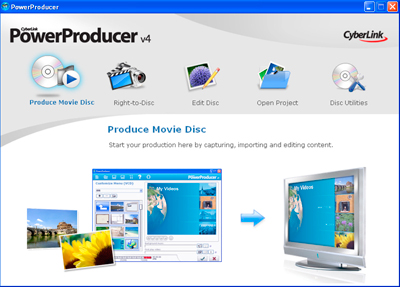|
Power Director 6: Not Really Ready for Prime Time
by Rodger Marion
As a media editor, I am most interested in editing software. Cyberlink makes an editing program and they sent three products, each containing a version of their editing program.
 DVD Suite contained the Power Director 6 program so I decided to install it as a starting point. It installed about a gigabyte of files and had a menu of nearly a dozen applications, including several programs that ran automatically. I don’t like programs running that I don’t want running, and after discovering that the version of Power Director was the “Express” version, I decided to remove the DVD Suite. I used CyberLink’s uninstall option and discovered that it only deleted the icons, not the software. (Alternate: use Windows “Add/Remove” program - not complete, but pretty good. Ed.) DVD Suite contained the Power Director 6 program so I decided to install it as a starting point. It installed about a gigabyte of files and had a menu of nearly a dozen applications, including several programs that ran automatically. I don’t like programs running that I don’t want running, and after discovering that the version of Power Director was the “Express” version, I decided to remove the DVD Suite. I used CyberLink’s uninstall option and discovered that it only deleted the icons, not the software. (Alternate: use Windows “Add/Remove” program - not complete, but pretty good. Ed.)
 Moving on to Power Producer. This application is focused on acquiring media and creating DVDs (It supports Blu-ray Disc and HD DVD formats), and it contains Power Director Express. It seemed limited from an editing perspective, so I turned to the full version. Moving on to Power Producer. This application is focused on acquiring media and creating DVDs (It supports Blu-ray Disc and HD DVD formats), and it contains Power Director Express. It seemed limited from an editing perspective, so I turned to the full version.
 Power Director 6 is designed for capturing DV and HDV video, editing, and producing standard definition DVDs or web-compatible files. It does not support the creation of Blu-ray or HD DVDs. It will write files to disc in DV or MPEG formats, Apple iPod format, Sony PSP format or upload directly to YouTube. It will write to tape in both DV and HDV formats. The program works with Windows Vista, 2000 and XP. It is optimized for dual-core Intel processors and needs at least a Pentium 4, 2.2GHz. It works with 512MB RAM. Cost: $89.95 direct from Cyberlink as a download, or $69.99 in a box from Amazon.com. Power Director 6 is designed for capturing DV and HDV video, editing, and producing standard definition DVDs or web-compatible files. It does not support the creation of Blu-ray or HD DVDs. It will write files to disc in DV or MPEG formats, Apple iPod format, Sony PSP format or upload directly to YouTube. It will write to tape in both DV and HDV formats. The program works with Windows Vista, 2000 and XP. It is optimized for dual-core Intel processors and needs at least a Pentium 4, 2.2GHz. It works with 512MB RAM. Cost: $89.95 direct from Cyberlink as a download, or $69.99 in a box from Amazon.com.
The installation program offered no options and installed without a hitch. There was an update patch on the web site, and I installed it. The update is important as a number of annoying errors were fixed by the update. I did not have to call technical support, and they provide the usual toll-free phone line and web-based support options.
Testing was done on a Dell Dimension 3000 with a 2.8GHz Intel Pentium 4 processor, 1GB RAM and Windows XP Pro SP2. Files were stored on an external hard drive connected by a Firewire 400 connection. I used the program to edit a short movie dealing with a road washed out by a flood.
The program has four main divisions: Capture, Edit, Produce and Create Disc.
Capture
The program has lots of input options. It tries to decide which options are available to you and highlights them for selection. For my computer, it accurately claimed to be able to capture from DV camera, TV, PC microphone, and DVD disc. Not available were HDV camera, digital TV, web-camera, and CD disc. DV input via Firewire was fine. I used scene detection by time code and files were written to the external hard drive with no dropped frames. It created 20 files, about four minutes and 800MB, on the drive in DV-AVI Type-1 format.
ESPdit
The editing screen is divided into three areas: Bins, Preview Window, and Time Line. There are bins for video clips, music, transitions, effects, etc. The clips I captured were already in the media bin, and I was ready to edit.
Preview Window – You can see any clip in the preview window. You can scrub through the clip, but you cannot set in and out points in the preview window. You must drag the clip to the time line to trim it.
The time line provides a number of editing tracks: Video, Effect, PiP, Title, Voice, and Music.
Video Track - When you select a clip on the video track, you are presented with four tabs: Trim (set in and out points), Multi-trim (set several in and out points to create separate clips and remove sections.), Speed (fast or slow motion effects), and Color (adjust color balance and audio). You can also double-click on a clip to view it in the trim window, set in and out points, and adjust volume.
Effects Track – A number of effects are supplied and they can be applied to clips on the Video Track.
PiP (Picture in a Picture) Track - Add a clip to the timeline on the PiP track, then double-click on the clip to open the PiP Designer. It let me set the PiP to fade-in and out and to position it in the frame.
Title Track – Title tool was acceptable. One of the pre-set fonts was pleasant, defaulted to a transparent background, and I added a fade in and out. I saved it as a custom title and used it later in my project.
Voice Track – I wanted the voice part of one clip to carry over to several other clips, so I split the audio/video tracks. It moved the audio to the voice track and I could adjust it as I wanted. There are no vu meters for the audio playback so setting levels is guesswork.
Music Track – Used Magic Music feature. Picked a relatively appropriate piece from the free music selections supplied, dropped it on the music track, and dragged it to fit the project. The music adapted itself to end gracefully at the end of the project. Nice. The program lets you purchase other music selections. Music is $7 a cut for private use and $20 a cut if you want to distribute your product.
You cannot add more tracks. This is a real limitation but also a compromise for the novice user, and this is a program for the novice.
During editing, the program crashed a few times in the manner common to video editing programs. If one does too many things too quickly (scrub video, switch tracks, adjust volume, etc.) the program gets confused and crashes. At one point the preview window had sound but no picture; just a black screen. Saving the project, closing the program, and re-starting it restored the preview function.
Produce
This section lets you create files from your project. First, I decided to create a full size DV-AVI file as a backup of my project. The resulting file looked very good in Windows Media Player.
I then used the publish-to-YouTube feature. First, the program needs to ask YouTube for permission to access your account. If you do not have an account, you can establish one. Power Director would not let me write in the title or tags labels and would not go to the next step unless I did, thus that was the end of my YouTube experiment. I did however make a QuickTime file and uploaded it myself. YouTube does not display wide-screen (16x9) movies and my movie was wide-screen. I made a new 4x3 project in Power Director, put the DV-AVI file of the finished movie into a PiP and sized it to give a letter-box version. Thus, you can go to www.youtube.com/rodgermarion and play the movie “Smith Creek Flood.”
Create Disc
This section provides a very simple, pick-from-a-few-options DVD designer and producer. I tried to burn a DVD but that failed, and writing the DVD files to the disk also failed. Perhaps Cyberlink wants you to buy DVD Suite.www.cyberlink.com
Conclusion. For more info, updates and forums go to . Overall, Power Director has many features that make it a viable option for the novice editor. If you have a bunch of videos and want to recast them as shorter, more interesting productions, and output them as files, then this program may suit your needs. Then again, if you need greater flexibility in your editing process and your output options, you will want to check out other products.
Rodger Marion, former HAL-PC member and Movie Editing class instructor, lives in Wimberley, Texas and produces movies for entertainment and education. He is also Professor Emeritus at the University of Texas Medical Branch. He teaches graduate courses using the Internet and videoconferencing. Contact him at rodger@smithcreekstudios.com or find out more at http://rodgermarion.utmb.myefolio.com.
|

